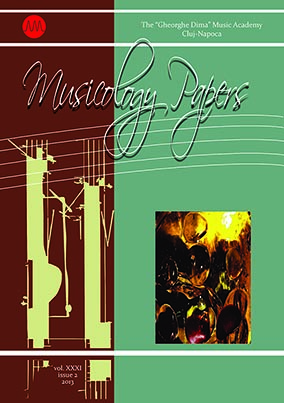«Vordergrund» and «Hintergrund» – A Fundamental Contrast in the Corpus of the Musical Work
«Vordergrund» and «Hintergrund» – A Fundamental Contrast in the Corpus of the Musical Work
Author(s): Alexandru BobocSubject(s): Fine Arts / Performing Arts, Music
Published by: MediaMusica
Keywords: linguistic act;musical act;ergon;energeia;foreground (Vordergrund);background (Hintergrund);appearance;composition;performance;identity of indiscernibles
Summary/Abstract: In order to understand the specific nature of the musical act both in its ontological reality and as a hermeneutical projection, we have organized our paper into 11 successive sections, as follows:1. It is a matter of course that although natural language and music have their distinct characteristics, they are based essentially on the same fundamental premises that ensure their presence as an act. To clarify the relationship between the linguistic act and the musical act, we will start from the basic considerations introduced by Humboldt. Essentially, they tend to consider language as an essential form that lives through unity and vitality. 2. To understand the musical act as a language, the considerations on language are paramount. Thus, the musical phenomenon is a language put into action, which presents both a sensibly real interface and a deeper projection that lies in the essential unity of compositional thinking based on invention.3. Given that “the artistic miracle of a musical work” implies more than we can physically hear, it is necessary to investigate the “relationship of appearance” that characterizes the mode of being of the musical act. Thus, the musical art does not transpose the idea to reality, but only represents it on a higher plane. 4. While further investigating the composer and the realization of the musical composition, the same “relationship of appearance” is immediately brought to the fore. Thus, two strata are identified in the presence and effect of the musical act – the foreground (Vordergrund) and, necessarily, the background (Hintergrund), which the act of composition brings in a sensible and also significantly hermeneutical synthesis. 5. The essential thing is therefore this different thing, which is no longer sensible. Given that in music, the foreground and the background are much closer than in other arts, their duality has long been misunderstood. This tense dynamic contrast between strata is the very essence of a musical work.6. This unity and opposition between strata is even more necessary in music than in other arts. Music needs to be transposed to reality through the art of execution, in order for the musical work to be brought into effect and presence. The composer and the performing musician constitute what in philosophy we would call the “condition of possibility” of the musical work, which, beyond being a creation, has to be brought into presence, into effect, through the audible performance.7. The background is often mysterious and difficult for the aesthetic understanding. We will resort here to N. Hartmann's analyses, particularly to those addressing the “the phenomenon of the background in music”, which are both aesthetically and philosophically exemplary. 8. The paradox of music lies in that it is capable of bringing to the senses something that is entirely different and distanced from what can be sensibly heard. To solve this essential duality is an ontological undertaking. The aesthetic object enters into a larger set of cultural phenomena, but at the same time falls entirely under the law of objectivation.9. What is mysterious in the nature of objectivation is and always remains this: how can the modelling of a sensible thing in the foreground be the carrier of a content that has an entirely different mode of being and that is there only for a consciousness? Here, a parallel must be drawn with the mode of understanding of the concept that appeals both to the sensible intuition and to the higher forms of intuition that lead to understanding. 10. The parallel between the concept and the work of art highlights the necessity of the permanent and higher synthesis of the musical act. The status of this unique unity may be understood by appealing to what Leibniz called the principle of the “identity of indiscernibles”, which in fact interferes with the principles of order and continuity, thus allowing the quasi-identity of musical strata, as well as the essential ontological difference between them to be viewed in a fair light. 11. The problem, therefore, is finding the “internal difference” between the two strata, which in the musical work lies both in itself and in its actual performance. At the same time, this subtle difference between the strata appears and varies constantly with every performance, which leaves the musical act perpetually available for possible new consummations.
Journal: Lucrări de Muzicologie
- Issue Year: 31/2016
- Issue No: 2
- Page Range: 19-40
- Page Count: 22
- Language: English
- Content File-PDF

